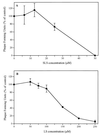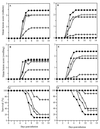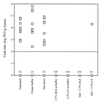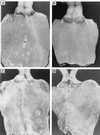Thermoreversible gel formulations containing sodium lauryl sulfate or n-Lauroylsarcosine as potential topical microbicides against sexually transmitted diseases
- PMID: 11353610
- PMCID: PMC90530
- DOI: 10.1128/AAC.45.6.1671-1681.2001
Thermoreversible gel formulations containing sodium lauryl sulfate or n-Lauroylsarcosine as potential topical microbicides against sexually transmitted diseases
Abstract
The microbicidal efficacies of two anionic surfactants, sodium lauryl sulfate (SLS) and n-lauroylsarcosine (LS), were evaluated in cultured cells and in a murine model of herpes simplex type 2 (HSV-2) intravaginal infection. In vitro studies showed that SLS and LS were potent inhibitors of the infectivity of HSV-2 strain 333. The concentrations of SLS which inhibit viral infectivity by 50% (50% inhibitory dose) and 90% (90% inhibitory dose) were 32.67 and 46.53 microM, respectively, whereas the corresponding values for LS were 141.76 and 225.30 microM. In addition, intravaginal pretreatment of mice with thermoreversible gel formulations containing 2.5% SLS or 2.5% LS prior to the inoculation of HSV-2 strain 333 completely prevented the development of genital herpetic lesions and the lethality associated with infection. Of prime interest, no infectious virus could be detected in mouse vaginal mucosa. Both formulations still provided significant protection when viral challenge was delayed until 1 h after pretreatment. Finally, intravaginal application of gel formulations containing 2.5% SLS or 2.5% LS once daily for 14 days to rabbits did not induce significant irritations to the genital mucosa, as demonstrated from macroscopic and histopathologic examinations. These results suggest that thermoreversible gel formulations containing SLS or LS could represent potent and safe topical microbicides for the prevention of HSV-2 and possibly other sexually transmitted pathogens, including human immunodeficiency virus.
Figures






References
-
- Baba M, Schols D, Nakashima H, Pauwels R, Parmentier G, Meijer D, Clercq E D. Selective activity of several cholic acid derivatives against human immunodeficiency virus replication in vitro. J Acquir Immune Defic Syndr. 1989;2:264–271. - PubMed
-
- Bourinbaiar A S, Lee-Huang S. Comparative in vitro study of contraceptive agents with anti-HIV activity: gramicidin, nonoxynol-9 and gossypol. Contraception. 1994;49:131–137. - PubMed
-
- Brugha R, Keersmaekers K, Renton A, Meheus A. Genital herpes infection: a review. Int J Epidemiol. 1997;26:698–709. - PubMed
Publication types
MeSH terms
Substances
LinkOut - more resources
Full Text Sources
Other Literature Sources
Medical

